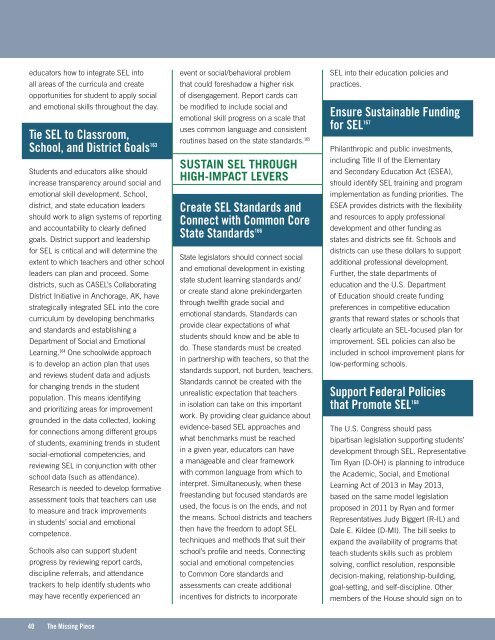CASEL-Report-low-res-FINAL
CASEL-Report-low-res-FINAL
CASEL-Report-low-res-FINAL
You also want an ePaper? Increase the reach of your titles
YUMPU automatically turns print PDFs into web optimized ePapers that Google loves.
educators how to integrate SEL into<br />
all areas of the curricula and create<br />
opportunities for student to apply social<br />
and emotional skills throughout the day.<br />
tie SEL to Classroom,<br />
School, and District Goals 163<br />
Students and educators alike should<br />
increase transparency around social and<br />
emotional skill development. School,<br />
district, and state education leaders<br />
should work to align systems of reporting<br />
and accountability to clearly defined<br />
goals. District support and leadership<br />
for SEL is critical and will determine the<br />
extent to which teachers and other school<br />
leaders can plan and proceed. Some<br />
districts, such as <strong>CASEL</strong>’s Collaborating<br />
District Initiative in Anchorage, AK, have<br />
strategically integrated SEL into the core<br />
curriculum by developing benchmarks<br />
and standards and establishing a<br />
Department of Social and Emotional<br />
Learning. 164 One schoolwide approach<br />
is to develop an action plan that uses<br />
and reviews student data and adjusts<br />
for changing trends in the student<br />
population. This means identifying<br />
and prioritizing areas for improvement<br />
grounded in the data collected, looking<br />
for connections among different groups<br />
of students, examining trends in student<br />
social-emotional competencies, and<br />
reviewing SEL in conjunction with other<br />
school data (such as attendance).<br />
Research is needed to develop formative<br />
assessment tools that teachers can use<br />
to measure and track improvements<br />
in students’ social and emotional<br />
competence.<br />
Schools also can support student<br />
prog<strong>res</strong>s by reviewing report cards,<br />
discipline referrals, and attendance<br />
trackers to help identify students who<br />
may have recently experienced an<br />
40 the Missing Piece<br />
event or social/behavioral problem<br />
that could fo<strong>res</strong>hadow a higher risk<br />
of disengagement. <strong>Report</strong> cards can<br />
be modified to include social and<br />
emotional skill prog<strong>res</strong>s on a scale that<br />
uses common language and consistent<br />
routines based on the state standards. 165<br />
SuSTAiN SEL THRougH<br />
HigH-iMPACT LEvERS<br />
Create SEL Standards and<br />
Connect with Common Core<br />
State Standards 166<br />
State legislators should connect social<br />
and emotional development in existing<br />
state student learning standards and/<br />
or create stand alone prekindergarten<br />
through twelfth grade social and<br />
emotional standards. Standards can<br />
provide clear expectations of what<br />
students should know and be able to<br />
do. These standards must be created<br />
in partnership with teachers, so that the<br />
standards support, not burden, teachers.<br />
Standards cannot be created with the<br />
unrealistic expectation that teachers<br />
in isolation can take on this important<br />
work. By providing clear guidance about<br />
evidence-based SEL approaches and<br />
what benchmarks must be reached<br />
in a given year, educators can have<br />
a manageable and clear framework<br />
with common language from which to<br />
interpret. Simultaneously, when these<br />
freestanding but focused standards are<br />
used, the focus is on the ends, and not<br />
the means. School districts and teachers<br />
then have the freedom to adopt SEL<br />
techniques and methods that suit their<br />
school’s profile and needs. Connecting<br />
social and emotional competencies<br />
to Common Core standards and<br />
assessments can create additional<br />
incentives for districts to incorporate<br />
SEL into their education policies and<br />
practices.<br />
Ensure Sustainable funding<br />
for SEL 167<br />
Philanthropic and public investments,<br />
including Title II of the Elementary<br />
and Secondary Education Act (ESEA),<br />
should identify SEL training and program<br />
implementation as funding priorities. The<br />
ESEA provides districts with the flexibility<br />
and <strong>res</strong>ources to apply professional<br />
development and other funding as<br />
states and districts see fit. Schools and<br />
districts can use these dollars to support<br />
additional professional development.<br />
Further, the state departments of<br />
education and the U.S. Department<br />
of Education should create funding<br />
preferences in competitive education<br />
grants that reward states or schools that<br />
clearly articulate an SEL-focused plan for<br />
improvement. SEL policies can also be<br />
included in school improvement plans for<br />
<strong>low</strong>-performing schools.<br />
Support federal Policies<br />
that Promote SEL 168<br />
The U.S. Cong<strong>res</strong>s should pass<br />
bipartisan legislation supporting students’<br />
development through SEL. Rep<strong>res</strong>entative<br />
Tim Ryan (D-OH) is planning to introduce<br />
the Academic, Social, and Emotional<br />
Learning Act of 2013 in May 2013,<br />
based on the same model legislation<br />
proposed in 2011 by Ryan and former<br />
Rep<strong>res</strong>entatives Judy Biggert (R-IL) and<br />
Dale E. Kildee (D-MI). The bill seeks to<br />
expand the availability of programs that<br />
teach students skills such as problem<br />
solving, conflict <strong>res</strong>olution, <strong>res</strong>ponsible<br />
decision-making, relationship-building,<br />
goal-setting, and self-discipline. Other<br />
members of the House should sign on to


